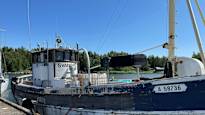In the tranquil waters of Lake Näsijärvi’s Kirnusalmi, faint traces on the rocks begin to emerge as our boat glides in. As we approach the shore, two figures come into view: a churn-carrying crone and a nude woman. These culturally significant rock paintings are on the brink of disappearing completely. Local resident, Matti Kivijärvi, expresses his concern over this loss. Kirnusalmi, nestled in the cultural landscape of Ruovesi’s route, sees sporadic boat traffic on sunny summer days. However, these passing boaters often overlook the paintings unless they are informed about them.
The fading artworks are not the originals but new versions painted by artist Tapio Salo in 1980. The original paintings, dating back to at least the 1880s, have sparked numerous tales about their mysterious creator. One legend suggests they were crafted by renowned Finnish artist Akseli Gallen-Kallela. Despite the proximity of Gallen-Kallela’s wilderness studio, Kalela, to Kirnusalmi, which fuels this theory, there is no concrete evidence linking him to the paintings. Tuija Wahlroos, director of the Gallen-Kallela Museum, casts doubt on this claim, citing the lack of any documentation or correspondence supporting his involvement in the project.
A more plausible scenario involves a painter with an artistic soul who worked as a log driver during the 19th century when logs were floated through Kirnusalmi. Kivijärvi muses that perhaps the painter was one of these loggers who spent time in the area waiting for favorable winds to navigate their rafts through the narrow strait. While Finland boasts around a hundred prehistoric rock paintings, like the well-known ones in Astuvansalmi, information on more recent rock art is scarce.
The Kirnusalmi paintings, however, lack protection under the Antiquities Act, and there is currently no designated entity responsible for their preservation. Ruovesi municipality, under the leadership of Mayor Toni Leppänen, acknowledges the value of the paintings but is cautious about restoration efforts. The dilemma lies in deciding whether to restore the original paintings or the 1980s replicas, which also hold copyright protection. The Pirkanmaa Provincial Museum recommended a “restorative approach” to maintain the local uniqueness of the rock art.
Despite the lack of a clear restoration plan, the paintings remain a topic of conversation among locals, especially the older generation, who fondly reminisce about the days when the artworks were visible. The gradual disappearance of the Kirnusalmi rock paintings is a topic of lament and regret in the community, underscoring the delicate balance between preserving cultural heritage and navigating the complexities of restoration efforts.









Leave feedback about this